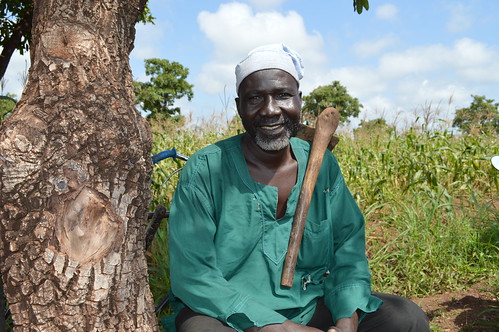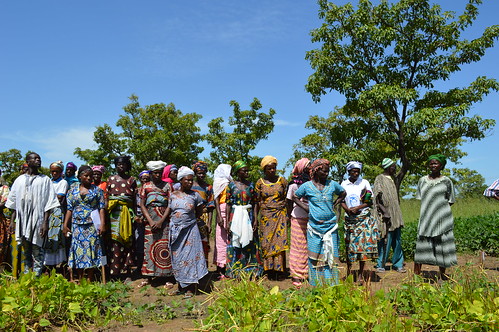Africa RISING – promoting sustainable intensification in Northern Ghana
Charlie Pye-Smith reports from Ghana for Africa RISING
“When I was young, we used to get eight or nine bags of maize per acre,” says Abukari Iddrisu. ”Now, I’m lucky if I get three bags, and this year it will be even less.”
Like most farmers in Tibognayali, a community of 1900 people in Ghana’s Northern Region, Abukari planted his maize when the first rains came in late May. “Then there was the drought in July, and our crops withered,” he says. He planted another maize crop in August, but he only expects to get two bags per acre, a fraction of what he needs to sustain his family of eight over the coming months.

However, farmers like Abukari know that the food and farming crisis in his region has been largely caused by factors unrelated to changing patterns of rainfall. “As the population has risen, we’ve been forced to practice continuous cropping and our land is now exhausted,” he says. “The loss of soil fertility is the main reason why our crop yields are so poor.” And it is one of the main reasons why there are such high levels of poverty and malnutrition in the savannas of northern Ghana.
But it needn’t be like this. Indeed, Abukari and his fellow farmers believe that a new research-for-development project will help them to restore their degraded lands, increase crop and livestock production, and provide them with better incomes.
Africa Research in Sustainable Intensification for the Next Generation (Africa RISING) – is a five-year program supported by the United States Agency for International Development (USAID) as part of the Feed the Future initiative. Launched in 2011 in three regions – Eastern and Southern Africa, the Ethiopian highlands and West Africa – it seeks to increase household productivity per unit of land, and therefore incomes, and improve the nutrition of smallholder crop-livestock farmers through a process known as sustainable intensification.
“Sustainable intensification is all about producing more crops and livestock from the same area of land, while at the same time reducing the negative environmental impacts associated with many current farming practices,” explains Asamoah Larbi, senior scientist at the International Institute of Tropical Agriculture (IITA) and leader of the Africa RISING project in West Africa.
Understanding the challenges
When an Africa RISING team of researchers first arrived in Tibognayali, they were met with some scepticism. “You see, in the past people from the government and other agencies would come here, and it was all talk, talk, talk – then leave,” explains farmer Abdullah Iddrisu. There were no practical demonstrations showing farmers how they could improve their productivity. “But we soon realised Africa RISING was going to be different,” he adds.
During 2012, Africa RISING launched ‘quick-win’ projects in 61 villages. These involved setting up small-scale trials of improved higher-yielding crop varieties. The aim was to get farmers interested in the project, and show that it would be highly participatory – with farmers involved in all activities – and intensely practical, in terms of improving productivity and incomes.
The first phase of Africa RISING’s research strategy involved an analysis of constraints and opportunities, based on discussions with some 4000 people in 48 communities in Northern, Upper West and Upper East Regions. The farmers identified key constraints to crop production as the lack of improved seeds, declining soil fertility, a high prevalence of pests and diseases, infestation by weeds, inadequate land preparation, and the high cost of inputs such as fertilisers and pesticides. As far as livestock were concerned, the farmers complained about poor access to veterinary services, high levels of mortality, and a wide range of diseases.
Together with the farmers, Asamoah and his team identified a number of activities which could improve food and nutritional security, reduce poverty and increase household incomes. The main task in 2013 was to establish trials of improved crop varieties at 25 sites: 10 in Upper West Region, 10 in Northern Region, and five in Upper East Region. The sites were chosen following detailed survey work by the International Food Policy Research Institute (IFPRI), which is responsible for the monitoring and evaluation aspects of the Africa RISING programme.

Mothers and babies
On a hot, blustery morning in early October, over 100 farmers from five communities in Upper West Region arrive by foot, bicycle, bus and truck at a site near Passe. They’ve come to see the ‘mother trials’ established by local farmers in collaboration with staff from the Ministry of Food and Agriculture (MOFA). There are six improved varieties of maize, six of cowpea and six of soybean, neatly laid out in blocks. One half have received the recommended dose of fertiliser; the other half, a larger quantity. There are also control plots of the traditional varieties used by local farmers.
It takes half an hour for everyone to walk around the mother trials and listen to brief explanations from MOFA staff about the characteristics of each variety. Some are early or extra-early maturing; some are drought resistant; others are resistant to striga, a purple-flowering weed that causes huge crop losses; some produce exceptionally high yields. Afterwards, MOFA invites the farmers – at least half are women – to stand next to the varieties which impress them most, and which they would like to grow in their own fields next year.
“These new varieties are so much better than our traditional varieties,” says Bariaisu Issahaku, a mother of six from Passe. She is particularly impressed by an early maturing variety of maize whose grain has high flour content. She also favours an improved variety of soybean which doesn’t shatter when the seeds mature, hence its local name ‘Jenguma’, which she translates as “lie down and wait for me.” And she likes the look of the cowpea Apagbaala, which, roughly translated, means ‘many wives’. It produces such plentiful crops that many pairs of hands (if not wives) are required to harvest it.
Many of the farmers who attend the field day have been involved in setting up mother trials, either here or in their own communities. This is a very collaborative business, with technicians from MOFA and IITA working with farmers to prepare the land, sow seeds, apply fertilisers and harvest the crops. Up to 30 farmers in each of the 25 intervention communities have also established ‘baby trials’ where they have planted improved varieties of maize, cowpeas and soybean on a smaller scale. These they manage themselves. At both mother and baby trials, farmers can compare the performance of improved varieties with traditional varieties, and learn about the best management practices.
According to Hamid Seidu, an IITA research technician in Upper West Region, the farmers’ response has been overwhelmingly positive. This doesn’t surprise him. “In this area,” he explains, “local yields of unfertilised traditional varieties of maize are around three bags per acre, and if farmers use recommended doses of fertilisers they might get seven bags.” This is the equivalent to 0.75 and 1.7 tonnes per hectare respectively. With the improved varieties grown in the mother and baby trials, farmers could get up to 18 bags of maize per acre – or 3.7 tonnes per hectare, over three times the average yield for sub-Saharan Africa.
The variety of maize which attracts most attention on this particular field day – similar events were held in all three Africa RISING regions in Ghana – is labelled TZEEQPM. Developed by IITA in Nigeria, it is an extra-early maturing, drought-and striga-resistant variety which has yet to be released for commercial sale. ”The fact that this is so popular with farmers is an important research finding,” says Amadou Alhassan, IITA’s chief research technician.
Looking to the future
“Our analysis of the data gathered at the mother and baby trials, together with the farmers’ preferred choices, will help us to shape our activities next year,” says Asamoah Larbi. Regional visits to the Africa RISING communities will also enable IITA and its many international and national partners to identify activities which bring about greater integration between crop growing and livestock rearing. This is an essential part of sustainable intensification.
“So far, there’s been very little work on livestock activities, but these are about to take off,” says Asamoah. “In some areas – and particularly in the Upper East Region – there is real potential to create highly integrated crop-livestock systems.” This could involve, among other things, growing dual-purpose crops which provide human food and livestock fodder, and using crop residues, such as maize and cowpea stovers, as green manure or fodder. Just as importantly, sustainable intensification will rely heavily on improving soil fertility through the use of animal manure.
During the course of the past year, the Africa RISING project in Ghana has established productive working relationships with a wide variety of partners, both national and international, and successfully tested a range of improved crop varieties. Just as importantly, the project has gained the trust of local communities. “It’s true that life is still difficult for us – at the moment, many of us don’t have enough to eat – but we’re very happy with Africa RISING,” says Abukari Iddrisu in Tibognayali. “Now, at last, we can see a light at the end of the tunnel.”
This is the first of Charlie’s blog posts. Read the others in the series:




